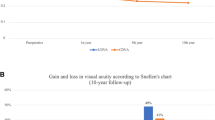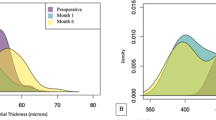Abstract
Objectives
The objective of this study is to determine the factors that predict long-term changes in refraction after lamellar keratoscleroplasty in paediatric patients with limbal dermoids.
Methods
A retrospective study of 66 children with limbal dermoids who had lamellar keratoscleroplasty correction with more than 1-year follow-up. Univariate and multivariate regression analyses were performed to investigate factors associated with the long term in refractive parameters, including spherical equivalent, astigmatism, and mean keratometry. The change value was defined as the postoperative refractive value minus the preoperative refractive value. The lower the value of changes, the more satisfied the effects on the correction of the preoperative refraction.
Results
A total of 66 patients (mean surgical age: 3.5 ± 2.1 years) were assessed with at least 1-year follow-up. Amblyopia treatment duration was the only independent factor predicting the long-term changes in spherical equivalent between baseline and last follow-up visit (β = −0.030, P < 0.001). Lesion encroachment on the central and paracentral cornea (β = 0.502, P = 0.024), suture-related complications (β = 1.571, P < 0.001) and graft rejection (β = 0.983, P = 0.035) were significantly correlated with long-term changes in astigmatism. The long-term changes in refraction were not correlated with surgical age, lesion size, lesion depth, steroid-induced high intraocular pressure and changes in mean keratometry.
Conclusion
Suture-related complications and graft rejection should be carefully observed and appropriately treated in order to avoid the possible postoperative increase in astigmatism, especially for patients with lesion encroachment on the central and paracentral cornea. The long-duration amblyopia treatment after surgery appears to have a better correction effect on spherical equivalent in the long term, compared with astigmatism.
Similar content being viewed by others
Log in or create a free account to read this content
Gain free access to this article, as well as selected content from this journal and more on nature.com
or
References
Nevares RL, Mulliken JB, Robb RM. Ocular dermoids. Plast Reconstr Surg. 1988;82:959–64.
Mansour AM, Barber JC, Reinecke RD, Wang FM. Ocular choristomas. Surv Ophthalmol. 1989;33:339–58.
Lang S, Böhringer D, Reinhard T. Surgical management of corneal limbal dermoids: retrospective study of different techniques and use of Mitomycin C. Eye. 2014;28:857–62.
Cho WH, Sung MT, Lin PW, Yu HJ. Progressive large pediatric corneal limbal dermoid management with tissue glue-assisted monolayer amniotic membrane transplantation: a case report. Medicine. 2018;97:e13084.
Stergiopoulos P, Link B, Naumann GO, Seitz B. Solid corneal dermoids and subconjunctival lipodermoids: impact of differentiated surgical therapy on the functional long-term outcome. Cornea. 2009;28:644–51.
Panton RW, Sugar J. Excision of limbal dermoids. Ophthalmic Surg. 1991;22:85–9.
Yamashita K, Hatou S, Uchino Y, Tsubota K, Shimmura S. Prognosis after lamellar keratoplasty for limbal dermoids using preserved corneas. Jpn J Ophthalmol. 2019;63:56–64.
Pirouzian A. Management of pediatric corneal limbal dermoids. Clin Ophthalmol. 2013;7:607.
Dana MR, Goren MB, Gomes JA, Laibson PR, Rapuano CJ, Cohen EJ. Suture erosion after penetrating keratoplasty. Cornea. 1995;14:243–8.
Crawford AZ, Meyer JJ, Patel DV, Ormonde SE, McGhee CNJ, Ophthalmology E. Complications related to sutures following penetrating and deep anterior lamellar keratoplasty. Clin Exp Ophthalmol. 2016;44:142–3.
Christo CG, van Rooij J, Geerards AJ, Remeijer L, Beekhuis WH. Suture-related complications following keratoplasty: a 5-year retrospective study. Cornea. 2001;20:816–9.
Maseedupally V, Gifford P, Lum E, Swarbrick H. Central and paracentral corneal curvature changes during orthokeratology. Optom Vis Sci. 2013;90:1249–58.
Shen YD, Chen WL, Wang IJ, Hou YC, Hu FR. Full-thickness central corneal grafts in lamellar keratoscleroplasty to treat limbal dermoids. Ophthalmology. 2005;112:1955.
Robb RM. Astigmatic refractive errors associated with limbal dermoids. J Pediatr Ophthalmol Strabismus. 1996;33:241–3.
Wilson SE, Bourne WM. Effect of recipient-donor trephine size disparity on refractive error in keratoconus. Ophthalmology. 1989;96:299–305.
Skeens HM, Holland EJ. Large-diameter penetrating keratoplasty: indications and outcomes. Cornea. 2010;29:296–301.
Scott JA, Tan DT. Therapeutic lamellar keratoplasty for limbal dermoids. Ophthalmology. 2001;108:1858–67.
Burillon C, Durand L. Solid dermoids of the limbus and the cornea. Ophthalmologica. 1997;211:367–72.
Lambert SR, Lynn MJ. Longitudinal changes in the spherical equivalent refractive error of children with accommodative esotropia. Br J Ophthalmol. 2006;90:357–61.
Park KA, Kim SA, Oh SY. Long-term changes in refractive error in patients with accommodative esotropia. Ophthalmology. 2010;117:2196–207.e1.
Hung LF, Crawford ML, Smith EL. Spectacle lenses alter eye growth and the refractive status of young monkeys. Nat Med. 1995;1:761–5.
Smith EL 3rd, Hung LF, Arumugam B. Visual regulation of refractive development: insights from animal studies. Eye. 2014;28:180–8.
Lambert SR, Lynn M. Longitudinal changes in the cylinder power of children with accommodative esotropia. J Am Assoc Pediatr Ophthalmol Strabismus. 2007;11:55–9.
Panda A, Ghose S, Khokhar S, Das H. Surgical outcomes of epibulbar dermoids. J Pediatr Ophthalmol Strabismus. 2002;39:20–5.
Newsom R, Ayliffe W, Dhar-Munshi S, Kirkham N, Liu C. Management of corneal opacification associated with epibulbar choristomata. Br J Ophthalmol. 1999;83:1403.
Melles GR, Binder PS. A comparison of wound healing in sutured and unsutured corneal wounds. Arch Ophthalmol. 1990;108:1460–9.
Fong LP, Ormerod LD, Kenyon KR, Foster CS. Microbial keratitis complicating penetrating keratoplasty. Ophthalmology. 1988;95:1269–75.
Ashar JN, Pahuja S, Ramappa M, Vaddavalli PK, Chaurasia S, Garg P. Deep anterior lamellar keratoplasty in children. Am J Ophthalmol. 2013;155:570–4.
Utine CA, Tzu JH, Akpek EK. Lamellar keratoplasty using gamma-irradiated corneal lenticules. Am J Ophthalmol. 2011;151:170–4.e1.
Stevenson W, Cheng SF, Emami-Naeini P, Hua J, Paschalis EI, Dana R, et al. Gamma-irradiation reduces the allogenicity of donor corneas. Investig Ophthalmol Vis Sci. 2012;53:7151–8.
Daoud YJ, Smith R, Smith T, Akpek EK, Ward DE, Stark WJ. The intraoperative impression and postoperative outcomes of gamma-irradiated corneas in corneal and glaucoma patch surgery. Cornea. 2011;30:1387–91.
Calhoun WR, Akpek EK, Weiblinger R, Ilev IK. Evaluation of broadband spectral transmission characteristics of fresh and gamma-irradiated corneal tissues. Cornea. 2015;34:228–34.
Islam MM, Sharifi R, Mamodaly S, Islam R, Nahra D, Abusamra DB, et al. Effects of gamma radiation sterilization on the structural and biological properties of decellularized corneal xenografts. Acta Biomater. 2019;96:330–44.
Pan Q, Jampel HD, Ramulu P, Schwartz GF, Cotter F, Cute D, et al. Clinical outcomes of gamma-irradiated sterile cornea in aqueous drainage device surgery: a multicenter retrospective study. Eye. 2017;31:430–6.
Acknowledgements
We thank Yujin Zhao, Xiaoyan Li and Yidan Fan for assisting in preparation of this paper. All of them above were from the Department of Ophthalmology, Eye, Ear, Nose & Throat Hospital of Fudan University.
Funding
The authors were supported by grants from the National Natural Science Foundation of China (81670820, 81670818 and 81870630); the Program for Professor of Special Appointment (Eastern Scholar) at Shanghai Institutions of Higher Learning; Shanghai Rising-Star Program (18QA1401100); and the Guizhou Science and Technology Program (2016–2825). The sponsor or funding organisation had no role in the design or conduct of this research.
Author information
Authors and Affiliations
Corresponding author
Ethics declarations
Conflict of interest
The authors declare that they have no conflict of interest.
Additional information
Publisher’s note Springer Nature remains neutral with regard to jurisdictional claims in published maps and institutional affiliations.
Rights and permissions
About this article
Cite this article
Fan, X., Hong, J., Xiang, J. et al. Factors predicting long-term changes in refraction after lamellar keratoscleroplasty in children with limbal dermoids. Eye 35, 1659–1665 (2021). https://doi.org/10.1038/s41433-020-01140-2
Received:
Revised:
Accepted:
Published:
Issue date:
DOI: https://doi.org/10.1038/s41433-020-01140-2
This article is cited by
-
Preoperative geometric parameters predict the outcome of lamellar keratoscleroplasty in patients with limbal dermoids
International Ophthalmology (2023)



